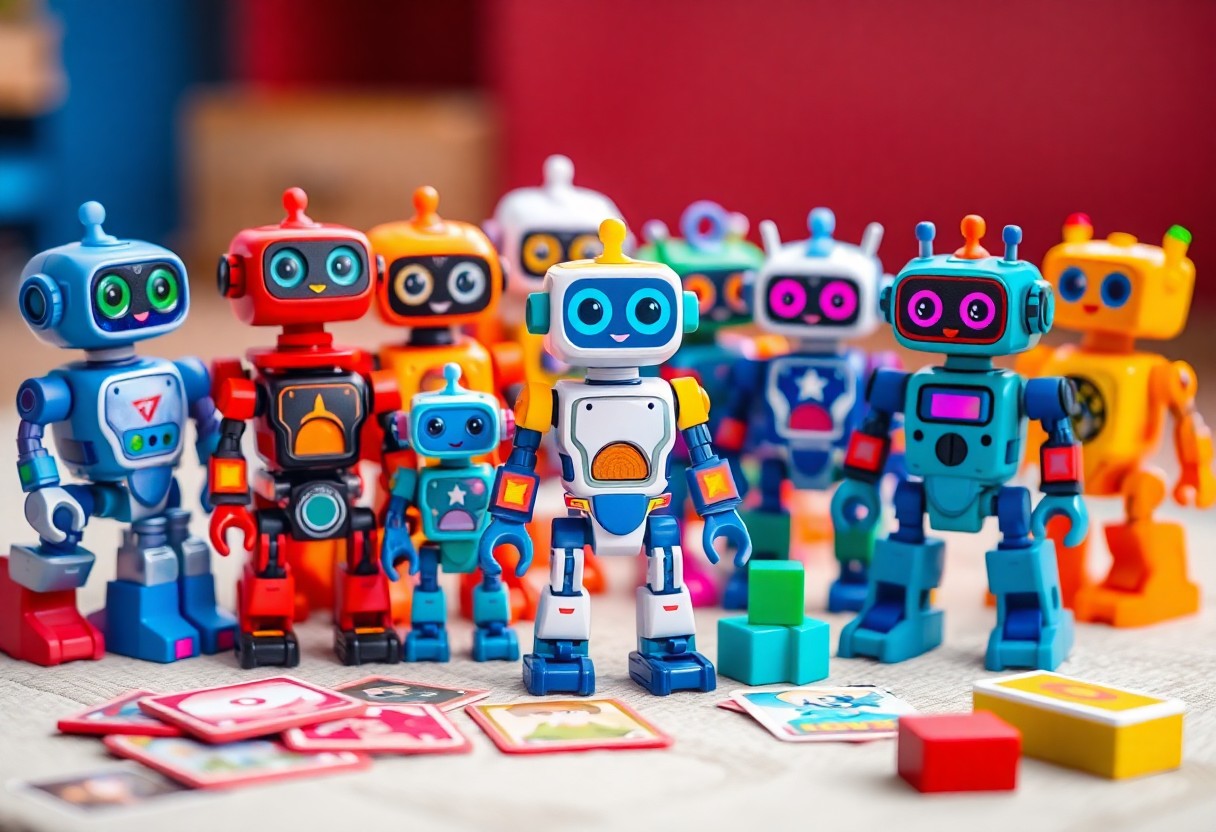Most parents and educators are discovering the advantages of incorporating toy robots into playtime. These interactive toys offer more than just entertainment; they significantly enhance your child’s learning and development. From fostering creativity and problem-solving skills to improving social interactions, the benefits are vast. In this guide, you’ll explore ten remarkable ways playing with toy robots can inspire and accelerate your child’s growth, ensuring they develop vital skills while having fun.
Types of Toy Robots
To effectively choose the right toy robot for your child, it’s important to understand the various types available in the market. This can enhance their play experience while maximizing learning opportunities. Here’s a breakdown:
| Type | Description |
| Educational Robots | Robots that teach coding and programming concepts. |
| Programmable Robots | Robots that can be programmed to perform specific tasks. |
| Remote-Controlled Robots | Robots that you can control using a remote. |
| Interactive Robots | Robots that engage in conversation and respond to commands. |
| Robotics Kits | DIY kits for building and programming your own robots. |
After you understand these types, you can better select a toy robot that aligns with your child’s interests and developmental needs.
Educational Robots
While educational robots are designed specifically to introduce children to fundamental concepts of science, technology, engineering, and mathematics (STEM), they serve as engaging tools for fostering curiosity and creativity. These robots often include user-friendly interfaces that make learning coding and basic programming enjoyable and accessible, thereby making complex concepts easier for young minds.
Programmable Robots
Types of programmable robots encourage creativity and problem-solving as you can set them to execute a variety of tasks. These robots require you to write simple codes or commands, which not only makes it fun but also aids in developing critical thinking and planning skills in your child.
Another advantage of programmable robots is that they promote hands-on learning. As you and your child experiment with different coding strategies to see how the robot responds, it allows for a trial-and-error approach to learning. This interactive experience not only keeps your child engaged but also builds perseverance and a growth mindset, enhancing overall cognitive development.
Benefits of Playing with Toy Robots
Now, playing with toy robots not only entertains but also provides numerous benefits that contribute to your child’s overall growth and development. Engaging with these machines encourages creativity, problem-solving skills, and can even lead to a deeper understanding of technology. As your child explores the various functionalities of toy robots, they initiate on a journey of learning that spans multiple domains, making it an enjoyable and educational experience.
Cognitive Development
One significant benefit of playing with toy robots is the enhancement of cognitive development. By programming and controlling these devices, your child exercises critical thinking and logical reasoning skills, paving the way for better problem-solving abilities. The challenges presented by toy robots encourage your child to think creatively and adapt their strategies, further boosting their intellectual growth.
Social Skills Enhancement
An important aspect of playing with toy robots is the enhancement of social skills. As your child interacts with others while engaging in cooperative play or competition, they learn to communicate effectively, share ideas, and negotiate roles within a group setting.
This not only fosters teamwork and collaboration but also allows your child to practice empathy by understanding the perspectives of others during gameplay. As they navigate these social dynamics, they’ll develop crucial interpersonal skills that will serve them well beyond playtime, enriching their relationships both in and out of school. Playing with toy robots can be a fun and interactive way to build a strong foundation for social interaction and emotional intelligence.
Tips for Choosing the Right Toy Robot
There’s a wide array of toy robots available, making it crucial to select one that aligns with your child’s interests and developmental stage. Consider the following tips:
- Assess your child’s age and skill level.
- Look for interactive features that promote engagement.
- Check for educational content that aligns with learning goals.
- Prioritize safety and durability of materials.
- Read reviews from other parents and educators.
Knowing your child’s preferences and what skills you want to develop will guide you to the ideal toy robot.
Age Appropriateness
Some toy robots are specifically designed for particular age groups, ensuring age-appropriate challenges and engagement. For younger kids, look for simple robots that enhance motor skills and basic problem-solving, while older children might benefit from more complex programmable robots that promote critical thinking and coding skills.
Learning Objectives
Choosing a toy robot with clear learning objectives can significantly enhance your child’s development. The right robot can teach coding, encourage creativity, or foster teamwork through shared play experiences.
A well-chosen toy robot can serve multiple educational purposes. For example, robots that require programming can introduce children to foundational coding concepts, while those with interactive storytelling can spark imagination and language skills. Identifying specific learning outcomes you want your child to achieve will help you pick a robot that complements their educational journey, making play both fun and enriching.
Step-by-Step Guide to Incorporating Toy Robots in Learning
Unlike traditional toys, toy robots offer a unique approach to learning and development. To effectively integrate them into your educational routines, follow these necessary steps:
| Step | Description |
|---|---|
| 1. Choose the Right Robot | Select a robot that matches your child’s age and skill level. |
| 2. Define Learning Goals | Determine specific skills you want to develop, such as problem-solving or creativity. |
| 3. Plan Structured Activities | Create activities that encourage hands-on interaction with the robot. |
| 4. Monitor Progress | Observe how your child interacts and evolves through the activities. |
| 5. Adapt as Needed | Be flexible in your approach; adjust activities based on engagement and understanding. |
Setting Up Activities
Now, you can begin setting up exciting activities that captivate both your child’s interest and their learning potential. Start by creating challenges or games that utilize the robot’s features. Incorporate elements of storytelling or real-world scenarios to make tasks relatable. This hands-on approach can make learning more engaging, fostering curiosity and enthusiasm for exploration.
Engaging Children
You have the power to engage your child in a fun and educational way through robot play. By allowing them to interact with the robot in a relaxed environment, you can spark their creativity and problem-solving skills. Encourage them to ask questions and explore different possibilities while programming or controlling the robot.
Learning through play is a beautiful journey, where children can express their imagination. When they manipulate the toy robot, they not only develop technical skills but also gain confidence in their abilities. Interactive play fosters collaboration and communication, as children often work together to tackle challenges, enhancing social skills along the way.
Factors Influencing Learning and Development with Toy Robots
Keep in mind that several key factors can influence your child’s learning and development when engaging with toy robots. Understanding these factors can enhance the benefits your child gains from their playtime. Consider the following:
- Type of robot
- Complexity of tasks
- Age appropriateness
- Parental involvement
- Collaboration with peers
Recognizing these factors will help you maximize the developmental advantages of toy robots for your child.
Interaction Quality
On the quality of interaction your child has with toy robots plays a significant role in their learning experience. Engaging in meaningful play that involves problem-solving, teamwork, and creativity allows your child to absorb concepts more effectively. When you actively participate with your child during playtime, it fosters deeper understanding and stimulates their imagination.
Frequency of Play
Little time spent with toy robots can limit their educational benefits. Regular interaction allows your child to explore different skills, encouraging critical thinking and creativity. The more consistently they engage with toy robots, the more opportunities they have to learn from trial and error, reinforcing knowledge and skills.
With frequent play, your child learns to navigate challenges and develops resilience. This repetition builds confidence and allows them to master skills over time. Establishing a routine that includes regular sessions with toy robots can further enhance their cognitive abilities and motor skills, ensuring a holistic approach to their learning and development.
Pros and Cons of Using Toy Robots in Development
Despite their benefits, incorporating toy robots into developmental play has both advantages and potential challenges. Below is a summary of some key points to consider:
| Pros | Cons |
|---|---|
| Enhances problem-solving skills | May require adult supervision |
| Promotes creativity and imagination | Can be costly |
| Facilitates STEM learning | Potential for screen dependency |
| Encourages teamwork and collaboration | May lead to frustration if too complex |
| Improves fine motor skills | Limited engagement for some children |
| Provides immediate feedback | Can be overly stimulating for some |
Advantages
Now, when you consider the advantages of toy robots, you’ll find they significantly contribute to your child’s learning experience. They foster problem-solving skills, encourage creativity, and enhance STEM learning. By engaging with robots, your child can develop teamwork abilities and improve their fine motor skills, all while having fun. The immediate feedback an interactive toy robot provides can motivate them to persist in their problem-solving efforts and enjoy the journey of learning.
Potential Drawbacks
Even though toy robots offer many developmental benefits, there are a few potential drawbacks to keep in mind. You may find that some toys require adult supervision to ensure proper use, which can be a consideration for busy parents. They can also be expensive and lead to screen dependency, especially if the robotic features require digital interaction. Additionally, if a robot’s challenges are too complicated, your child might experience frustration instead of engagement.
Advantages can sometimes lead to frustrations if the toys are not appropriately matched to your child’s skill level. You might find certain toy robots are overly complex or too simplistic, potentially losing their appeal. Moreover, while these gadgets support numerous skills, they can inadvertently encourage screen time over more traditional play. Striking a balance between robotic play and other types of interaction will enhance your child’s development without overwhelming them.
Final Words
Taking this into account, engaging with toy robots can significantly enhance your learning and development experience. These interactive tools not only promote creativity and problem-solving skills but also foster a deeper understanding of technology and engineering principles. By incorporating play with toy robots into your routine, you can improve cognitive abilities, social skills, and even emotional intelligence. Embrace the opportunities that toy robots offer, and watch as they transform your learning journey into a fun and enriching adventure.






